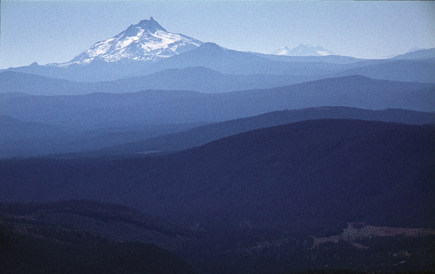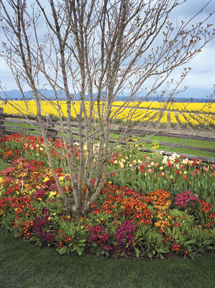The LaCie 700 Series LCD Displays; Color Performance Personified Page 2
So, now that the LaCie 720 display was all ready to be used with my system, the question for me was how to find out if its large color gamut was a significant and positive advantage for doing digital photographic work. My immediate thought was to test with the occasional images that I got to look good on screen but, even though my system was carefully color managed, would print weird and strange colors not seen on the display. So I went through my film and digital camera files to select out a lot of the “color” problems of the past.
Does Seeing All The Color Provide An Advantage?
Instead of jumping into the toughest challenges first, I wanted to get a clear impression of the difference with images that are recent and familiar, so I chose a set of Raw Canon EOS 5D images taken recently at my local flower greenhouse’s yearly open house. I launched Adobe Bridge, which is set to run under Adobe RGB. The look of these Raw files was more colorful than usual, especially considering they had not been processed, with a level of color greater than usual and close to what a finished image should be.
Well, OK, but how would Raw digital camera files appear in the full color gamut of monitor color space? I opened the same folder using Canon’s Digital Photo Professional application, which runs normally in monitor color space. The color of the flowers, at the 15 percent greater color gamut this display offers, appeared just too saturated, almost unreal, even though they were still unprocessed Raw camera files. This would be too much to work with, but fortunately Canon’s Digital Photo Professional has a preference option to display its reproduction of images in a chosen workspace profile like sRGB or Adobe RGB (1998).
 |
|
|
Setting it to Adobe RGB, the colors of the image appeared about the same as they appeared in Adobe Bridge. An initial conclusion I came to is that working in the full color gamut at monitor color space may be quite misleading because it displays a level of color saturation and brilliance that is not reproducible in a print or other standardized kinds of output. It also provided a reality confirmation that a working space profile like Adobe RGB or sRGB does in fact limit the color displayed, even if there is more potential color in the file. The working space RGB profile of an application, like all the versions of Photoshop, will only display within the color gamut limits of the profile.
I was also curious about very subtle coloration at the other end of the gamut, so opened one of the Raw images that featured some white flower blossoms. Even after the image file was processed and the gamut was adjusted and color balanced, the white blossoms did reveal some subtle tints of color variation in the image, a valuable feature in digital camera digital darkroom work for sure.
Moving on, I launched my personal favorite digital camera Raw image-processing application, LaserSoft’s SilverFast DCPro Studio, and picked a file to color correct, optimize, and adjust to be ready for printing. SilverFast DCPro Studio is a fully color-managed application like Photoshop, so I have it set up to display images using the Adobe RGB color space, consistent to the color space set in my Canon EOS 5D. Flowers, for an enthusiast shooter like me, are a peculiar subject that demands very precise and limited color adjustment. When adjusting and color correcting these images, I found it much easier to actually see every shade, tone, and hue in the display, getting it all to look “right,” then obtaining an image that would reproduce the same color in a fine inkjet print. Seeing all the color in Adobe RGB that is in the image is an invaluable advantage to getting it right in the end.
 |
|
 |
|
|
With scanned images that were recorded originally on film, you have a different challenge. The film used has its own particular color bias, so the question becomes: do you want to replicate the film image as exactly as possible or do you want to adjust color to look as much as possible like the original subject, or something in between? With some subjects, like people, you have a perceptual guide—skin tones. You have a limited range of color options to make a person’s complexion look normal and real. Being able to see all the complex and subtle coloration fully in the preview image when setting up a scan is a great advantage. And I soon found that scanning with the LaCie 720 LCD display makes it easier to adjust the image and obtain a scan that is much closer to what I had intended.
Based on these results I had acquired a sensitivity to how to work with what I was seeing, so with that confidence I began doing Photoshop adjustments to my “difficult” images. One in particular was a shot of a small cave in the red sandstone of the Valley of Fire, an hour east of Las Vegas. One band of deep red earth would always print too dark and deep in color compared to the rest of the scene as it appeared on screen. By using selective color adjustment in Photoshop to adjust the coloration in the image on screen with the LaCie display, I got the image to look as I wanted it to look in a print. The proof in the pudding was that this time, readjusted with the much fuller color of the LaCie display, I got the on-screen image to reproduce as a print without the usual discoloration of too dark and deep reds in one part of the image. To me this proved without doubt my long-standing belief that you cannot control what you cannot see, making results unpredictable.
With this very convincing example under my belt I went to work with the rest of the “problem” images. There were some distant mountain vistas, an old farm shot on a very dull day in eastern Oregon, an early rise of moonlight near Jackson Hole, Wyoming, portraits, and even many of my collection of flower photographs. I worked on each with good success, getting the image on screen to look the way I wanted to see it printed, and then making a print and finding that problems from the past were due to my not being able to see the image fully on screen before I committed them to prints.
 |
|
|
A New Bottom Line Ideal
To do the best digital photography you do need a decent computer, but from working with this LaCie display that reproduces all of the color in Adobe RGB, and more, I learned the first and foremost essential to getting the best out of the digital darkroom is to be able to reproduce all of the image information on screen accurately and fully. The LaCie 700 Series of displays do that in every respect. But like Ferrari and Jaguar sports cars, the LaCie 700 Series RGB-LED LCD displays are more expensive than most of us can afford. But fortunately, with digital technological improvements advancing rapidly and costs going down as better products become more plentiful, RGB-LED displays may soon be affordable, or at least a little more so. But if you can afford the best in just one dimension, one of these LaCie 700 Series RGB-LED LCD displays should be at the top of your list of priorities.
For more information, contact LaCie at: www.lacie.com.
David Brooks can be reached via e-mail at: goofotografx@gmail.com.
- Log in or register to post comments

































